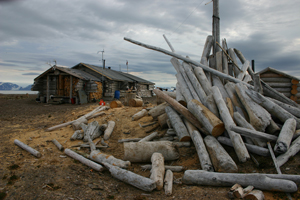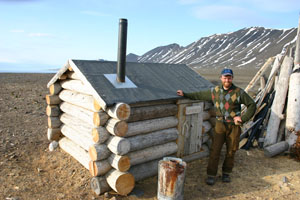Mushamna
[79° 35' N 14° 00' E]
By Øystein Overrein (ed.), Jørn Henriksen, Bjørn Fossli Johansen, Kristin Prestvold
Far into Woodfjorden there is a well equipped hunting cabin. It was built out of driftwood, large piles of fire wood and a rack where seal and reindeer carcasses are hung out of reach of the polar bears. The cabin’s inhabitants vary from year to year: the landlord is the Governor of Svalbard, and each tenancy is for one year only. Tour operators need to schedule visits with the tenant well in advance.
Take care:
- Landings near the cabin need to be arranged with the tenant well in advance.
- If the tenant does not want visitors, this has to be respected.
- Do not enter the cabin without an invitation to do so.
- Do not touch anything that belongs to the trapping station.
- Ask the tenant before you approach the dogs.
- Be aware of nesting common eiders and Arctic terns. Follow the path up to the cabin and be wary of where you tread.
 Lots of firewood is needed to keep warm. (Image: Bjørn Fossli Johansen / The Norwegian Polar Institute) Lots of firewood is needed to keep warm. (Image: Bjørn Fossli Johansen / The Norwegian Polar Institute)
 By the newly built sauna, hunter Jon Grande Dahl spent the winter of 2004-05 in the cabin. (Image: Bjørn Fossli Johansen / The Norwegian Polar Institute) By the newly built sauna, hunter Jon Grande Dahl spent the winter of 2004-05 in the cabin. (Image: Bjørn Fossli Johansen / The Norwegian Polar Institute)
Mushamna is situated on the eastern shore of Woodfjorden, across from Liefdefjorden. The cabin is situated on a headland about 1 km north of Mushamna (the lagoon).
The cabin in Mushamna was built by Reidar Hovelsrud in 1987. It is abnormally large compared to older hunters’ cabins in Svalbard. It has an outer room for hanging game and furs, a room in the middle with a workshop and an inner room with a lounge, a kitchen and a bedroom. The cabin was sold to the Norwegian State in 1997.
Most of the hunters’ cabins in Svalbard are in too poor a state to be available for overwintering. However, two of the cabins – Austfjordneset in Wijdefjorden and Mushamna – are well kept and are still in use for hunting all year round. Qualified applicants show their interest each year, and the decision of who gets to occupy the cabin is made by the Governor of Svalbard. This is free of charge. The tenancy begins late July and lasts for one year. It is possible to extend the stay for a following year after that.
The hunting takes place both ashore and on the ice. The main prey is the Arctic fox, which is captured using traditional trapdoors or hit traps. Seals, ptarmigan, pink-footed geese and a small number of reindeer are also captured. In addition to this, fishing for Arctic char takes place in both freshwater and in the sea. Collecting down on the islands in the fjord is permitted, but this is not very popular.
Special details
Visits have to be agreed between tour operators and hunter (through HF radio well in advance). Since the tenants are not the same each year, it will vary as to whether suggested visits are well received or not. If the hunter does not want visitors, this has to be respected.
Normally there are several huskies tied up north of the cabin. They let the tenant know of any polar bears in the vicinity, but are also used to pull sledges etc. They will have different reactions to strangers. Consult the hunter before you approach them.
Vulnerable elementsCommon eiders and Arctic terns nest by the beach and around the station. Follow the path up to the cabin and be careful where you tread to avoid crushing eggs or disturbing nesting birds. The eiders are difficult to spot, even up close. Avoid frightening them away from the nest. Landing sitesJust below the cabin. Avoid using Mushamna (the lagoon) because polar bears tend to roam around here.
|